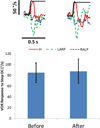Safe direct current stimulation to expand capabilities of neural prostheses
- PMID: 23476007
- PMCID: PMC4050981
- DOI: 10.1109/TNSRE.2013.2245423
Safe direct current stimulation to expand capabilities of neural prostheses
Abstract
While effective in treating some neurological disorders, neuroelectric prostheses are fundamentally limited because they must employ charge-balanced stimuli to avoid evolution of irreversible electrochemical reactions and their byproducts at the interface between metal electrodes and body fluids. Charge-balancing is typically achieved by using brief biphasic alternating current (AC) pulses, which typically excite nearby neural tissues but cannot efficiently inhibit them. In contrast, direct current (DC) applied via a metal electrode in contact with body fluids can excite, inhibit and modulate sensitivity of neurons; however, chronic DC stimulation is incompatible with biology because it violates charge injection limits that have long been considered unavoidable. In this paper, we describe the design and fabrication of a Safe DC Stimulator (SDCS) that overcomes this constraint. The SCDS drives DC ionic current into target tissue via salt-bridge micropipette electrodes by switching valves in phase with AC square waves applied to metal electrodes contained within the device. This approach achieves DC ionic flow through tissue while still adhering to charge-balancing constraints at each electrode-saline interface. We show the SDCS's ability to both inhibit and excite neural activity to achieve improved dynamic range during prosthetic stimulation of the vestibular part of the inner ear in chinchillas.
Conflict of interest statement
The terms of these arrangements are being managed by the Johns Hopkins University in accordance with its conflict of interest policies.
Figures






References
-
- Guenther T, Lovell NH, Suaning GJ. Bionic vision: system architectures: a review. Expert. Rev. Med. Devices. 2012 Jan.9(no. 1):33–48. - PubMed
-
- Merrill DR, Bikson M, Jefferys JGR. Electrical stimulation of excitable tissue: design of efficacious and safe protocols. Journal of Neuroscience Methods. 2005;141(no. 2) - PubMed
-
- Robblee L, Rose T. Electrochemical guidelines for selection of protocols and electrode materials for neural stimulation. In: McCreary DB, Agnew WF, editors. Neural Prostheses: Fundamental Studies. Prentice-Hall; 2003.
-
- Rose TL, Robblee LS. Electrical-Stimulation with Pt Electrodes .8. Electrochemically Safe Charge Injection Limits with 0.2 Ms Pulses. IEEE Transactions on Biomedical Engineering. 1990;37(no. 11) - PubMed
Publication types
MeSH terms
Grants and funding
LinkOut - more resources
Full Text Sources
Other Literature Sources

